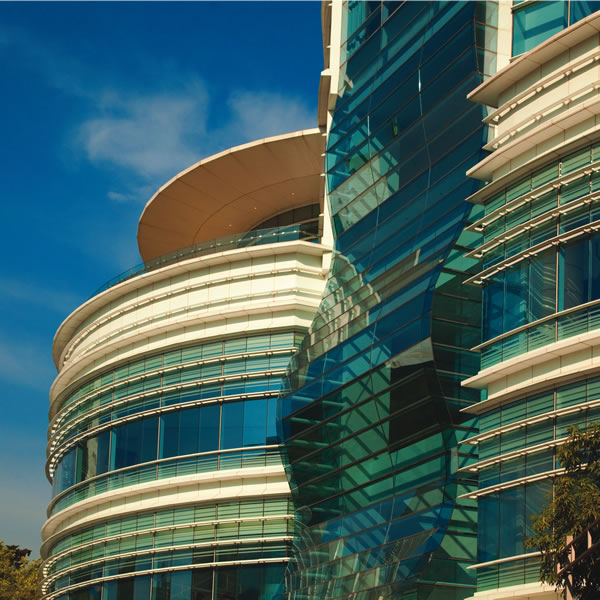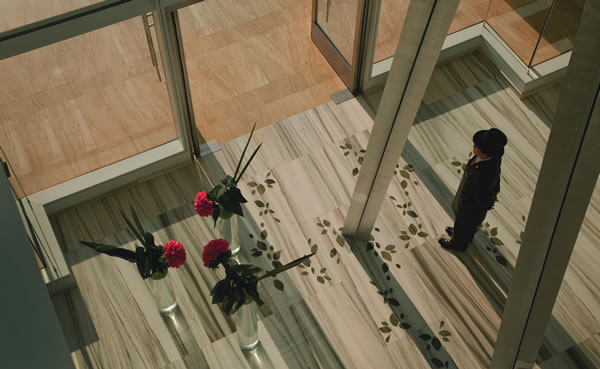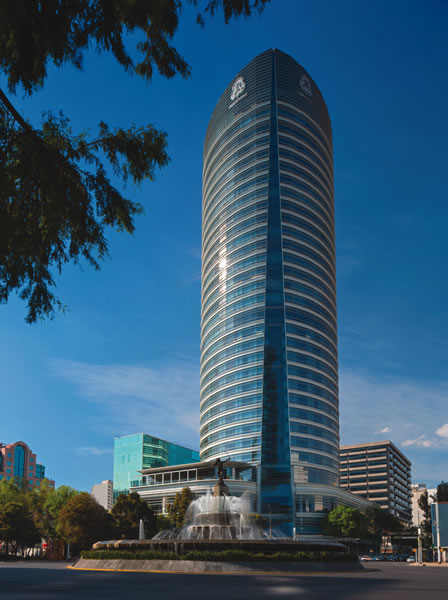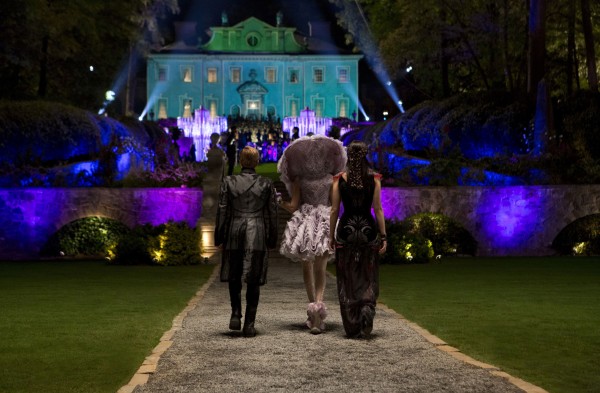Explore the stunning architecture of The St. Regis Mexico City.
By Richard Carroll
Upon first sight of the ultra-modern 33-story St. Regis Mexico City, the imagination takes flight at the ingenuity, inspiration and innovation of the towering structure. Great sheets of glass and metal are rounded like the bow of a ship, leaving straight lines that seem to disappear into the sky. Standing on historic tree-lined Avenida Paseo de la Reforma, near the beloved Fountain of Diana the Huntress and steps from famed Chapultepec Park, The St. Regis Mexico City appears to be taking flight and sailing away into the horizon in a swirl of architectural grandeur.
In 2009, the five-star beauty opened its doors with 189 guest rooms, 36 specialty suites, a full-service Remède Spa, fitness center, indoor swimming pool, several dining establishments, sizeable event space and a collection of breathtaking artwork. Award-winning architectural firm Pelli Clarke Pelli designed this first-ever St. Regis hotel in Latin America, which is recognized as one of the tallest buildings in the region. The grand St. Regis tower rises to 492 feet, capped with a helipad tucked away on the roof of the 33rd floor. Guests enjoy spectacular vistas from every floor, including that of the immense Popocatepetl volcano, located approximately 40 miles southeast.
“The design of the St. Regis is simple and sculptural,” says Cesar Pelli, architect and senior principal at Pelli Clarke Pelli. “The shape of the tower has an old lineage, yet is a contemporary presence appropriate to the new Mexico.”
Bringing the Vision to Life
Pelli, who was born and raised in Argentina, is recognized by the American Institute of Architects as one of the 10 most influential living American architects. He has led the Pelli Clarke Pelli architectural team in designing a prestigious list of more than 75 major buildings and metropolitan landmarks, which include Hong Kong’s Two International Finance Centre and the significant Petronas Twin Towers in Kuala Lumpur, Malaysia.
It’s no surprise that The St. Regis Mexico City selected the prominent firm to develop the ambitious design for the striking tower in the country’s capital. Ed Dionne, senior associate principal at Pelli Clarke Pelli, worked closely with Pelli in the development of the hotel and was passionate about making a mark on the Mexico City skyline.
“Looking down at the grove of trees on [Avenida Paseo de la] Reforma, we needed to add to this boulevard of monuments by exploring circles,” he says. “We needed something circular.”
To create a dramatic architectural impact, the firm drew attention to the soft slope leading from the tower’s highest point, utilizing arched shapes to stand apart from the avenue’s other architectural monuments.
“Its form is that of an equilateral triangle with curved sides, pointing towards the Diana Fountain in a gesture of respect,” Pelli describes. “To strengthen this relationship, the corner that addresses the fountain is an undulating facet that presents a dramatic face towards it and marks the entrance to the building. At this corner, the tower rises from the earth and aims towards the sky.
“The exterior is an elegant, delicately proportioned wall of floor-to-ceiling clear glass and white aluminum sunshades wrapping the curved forms of the triangle,” he continues. “The curved wall of glass catches the changing light with their multiple facets.”
An Esteemed Locale
Accepted by many as the world’s largest city, Mexico City combines fascinating layers of history, architecture, imposing parks, traditional markets and momentous sculptured statues. It is the country’s most important political, cultural, educational and financial center, hosting an immense range of fashion, art and fine dining.
“Our client came to us from a very special place,” Dionne says. “The magnitude of the location in this proud city is incredible, the St. Regis being very close to the statue and Fountain of Diana the Huntress.
Located in a large valley in the center of Mexico at an altitude of 7,350 feet, the city was originally built on an island in Lake Texcoco by the Aztecs in 1325, and rebuilt by the Spaniards on the vacillating and fickle lakebed in 1524.
Ranked among the world’s safest skyscrapers, Pelli Clarke Pelli anchored the St. Regis to the surface of the earth. It is supported by 225 concrete piles penetrating to a depth of 180 feet through the lakebed to solid soil, along with 12,000 tons of structural steel and reinforcement and 31,000 cubic meters of support concrete.
Indoor Exploration
Inside the hotel, the lobby atrium greets visitors on the ground floor; however, an architectural decision was made to lift the lobby up to the third floor away from the traffic and street noise, allowing guests to enjoy a wide landscaped terrace with views of the fountain. On the first three floors, retail space, banquet halls and restaurants provide a bustling center for entertainment and gathering.
An intriguing decision for the St. Regis and Pelli Clarke Pelli was the design and placement of the Remède Spa and fitness center. For a more tranquil experience, Remède Spa is tucked away on the 15th and 16th floors of the hotel and features an indoor pool with singular views. The full-service spa and fitness center are the essence of relaxation where guests feel the spirit of comfort and opulence with the first panoramic indoor pool in Mexico City, separate men’s and women’s steam rooms and saunas, two hot tubs, space designed for large lockers, a yoga and Pilates studio and a fitness room filled with cardiovascular and strength training equipment, including a Kinesis wall.
Throughout the hotel, the St. Regis, Pelli Clarke Pelli and interior design firm Yabu Pushelberg pay homage to Mexico’s distinctive style in fine art, murals, handicrafts, woodwork, ceramics and weaving. The design team engaged local artists to create an array of artistic detail such as furniture and imaginative wall finishes and hangings. Stunning onyx mosaics with slabs of pale green marble are installed in guest bathrooms, while classic Mexican metal and leather detail are used throughout the interior. Lavishly adorned, Mexican influenced, custom-made carpets and dazzling Gabriel Macotela murals enhance the third floor reception area.
Hallmark Interior Design
Described as design geniuses by some in the industry, Yabu Pushelberg’s illustrious interior spaces have garnered countless awards, including induction into the Interior Design magazine Hall of Fame. With offices in Toronto and New York City, the firm’s clients include The St. Regis Mexico City, Tiffany & Co., Louis Vuitton, Carolina Herrera, Lane Crawford and numerous others. The roots of the partnership were created when George Yabu and Glenn Pushelberg were design students at Toronto’s Ryerson Polytechnical Institute (later renamed Ryerson University). Both began with private practices, Yabu in residential design, Pushelberg focusing on retail, but in 1980, they merged their design expertise and founded Yabu Pushelberg.
Together, the partners at Yabu Pushelberg transformed the interior of the St. Regis into a skillful and clever work of art within itself, bringing architecture and culture together cohesively in a clearly balanced rhythm that unifies the interior design.
The firm, honored with the James Beard Foundation Award for Restaurant Design, went a step further with the elegant King Cole Bar, a trademark room of St. Regis Hotels & Resorts around the world. Designed with traditional furniture, dark wood walls, Mexican-style panel doors and carpeted floors in a soft, moss green motif, it is an ideal spot for an evening of libation and conversation.
In contrast, the inviting and airy guest rooms and suites are awash with light and dressed in neutral tones with a touch of purple and green hues, while neutral bed linens stand out against leather headboards designed with intricate woven detail.
Whether drinking in the captivating exterior views of the hotel or enjoying the elegant local touches of its interior, guests at The St. Regis Mexico City will delight in the special aesthetic vision created by Pelli Clarke Pelli and Yabu Pushelberg. Combining architecture with interior design, the grand hotel has made an artistic statement from its location on the iconic Avenida Paseo de la Reforma.












